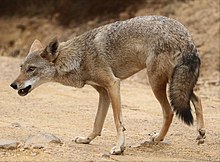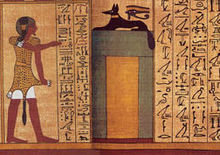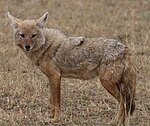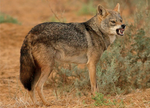African wolf
| African wolf Temporal range:
Middle Pleistocene – Recent 0.6-0 Ma | |
|---|---|

| |
| African wolf in Haizer, Algeria | |
| African wolves howling | |
| Scientific classification | |
| Domain: | Eukaryota |
| Kingdom: | Animalia |
| Phylum: | Chordata |
| Class: | Mammalia |
| Order: | Carnivora |
| Family: | Canidae |
| Genus: | Canis |
| Species: | C. lupaster
|
| Binomial name | |
| Canis lupaster | |
| Subspecies | |
| |

| |
| Synonyms | |
The African wolf (see below for other names; Canis lupaster) is a
The African wolf was previously classified as an African variant of the golden jackal (Canis aureus), with at that time at least one subspecies (C. a. lupaster) having been classified as a wolf. In 2015, a series of analyses on the species' mitochondrial DNA and nuclear genome demonstrated that it was, in fact, distinct from the golden jackal, and more closely related to the gray wolf and the coyote (Canis latrans).[5][6] It is nonetheless still close enough to the golden jackal to produce hybrid offspring, as indicated through genetic tests on jackals in Israel,[5] and a 19th-century captive crossbreeding experiment.[7] Further studies demonstrated that it is the descendant of a genetically admixed canid of 72% gray wolf (Canis lupus) and 28% Ethiopian wolf (Canis simensis) ancestry.[8]
It plays a prominent role in some African cultures; it was considered sacred in
Names
The taxon is known under the following names: African wolf,[13][14] African golden wolf,[15][16] golden wolf,[17] African golden jackal,[5] North African jackal,[18][19][20] African jackal,[21] gray jackal,[20] wolf jackal,[22][23] jackal wolf,[24] Egyptian wolf,[25] Egyptian jackal.[25]
Local and indigenous names:
| Linguistic group or area | Indigenous name |
|---|---|
| Afar | Wucharia[26] |
| Amazigh | Ouchan asian [27] Ouchan akhatar [27] |
Amharic |
ተረ ቀበሮ (Tera kebero)[28] |
Arabic |
ابن آوى (Ibn awa)[29] |
| Fula | 𞤧𞤵𞤲'𞤣𞤵 Sundu[28] |
| Hausa | Kyarkeci[28] |
| Somali | Eey |
| Songhai | Nzongo[28] |
| Swahili (standard) Swahili (Tanzania) |
Bweha wa mbuga[30] Bweha dhahabu[28] |
Tigrinya |
ቡኳርያ (bukharya)[31] |
| Wolof | Tili[28] |
Description

The African wolf is intermediate in size between the African jackals (L. mesomelas and L. adusta) and the small subspecies of gray wolves,[13] with both sexes weighing 7–15 kg (15–33 lb), and standing 40 cm in height.[4] There is however a high degree of size variation geographically, with Western and Northern African specimens being larger than their East African cousins.[13] It has a relatively long snout and ears, while the tail is comparatively short, measuring 20 cm in length. Fur color varies individually, seasonally and geographically, though the typical coloration is yellowish to silvery grey, with slightly reddish limbs and black speckling on the tail and shoulders. The throat, abdomen and facial markings are usually white, and the eyes are amber-colored. Females bear two to four pairs of teats.[4] Although superficially similar to the golden jackal (particularly in East Africa), the African wolf has a more pointed muzzle and sharper, more robust teeth.[5] The ears are longer in the African wolf, and the skull has a more elevated forehead.[32]
| Sex and Location | Numbers of individuals (n) | Weight (X, kg) | Weight (Range, kg) |
|---|---|---|---|
| Males (Ethiopia) | 6 | 9.0 | 7 - 10 |
| Females (Ethiopia) | 4 | 8.1 | |
| 8 year old melanistic male (Egypt) | 1 | 19 | NA |
| Adults (Egypt) | 21 | 14 | 13 - 19.7 |

Taxonomy
Early writings
The African wolf was first recognised as being a separate species from the golden jackal by

An attempt was also made in 1821 to hybridise the two species in captivity, resulting in the birth of five pups, three of which died before weaning. The two survivors were noted to never play with each other, and had completely contrasting temperaments: One pup inherited the golden jackal's shyness, while the other was affectionate toward its human captors.[7] English biologist G.J. Mivart emphasized the differences between the African wolf and the golden jackal in his writings:
... it is a nice question whether the Common Jackal of North Africa should or should not be regarded as of the same species [as the golden jackal] ... Certainly the differences of coloration which exist between these forms are not nearly so great as those which are to be found to occur between the different local varieties of C. lupus. We are nevertheless inclined ... to keep the North-African and Indian Jackals distinct ... The reason why we prefer to keep them provisionally distinct is that though the difference between the two forms (African and Indian) is slight as regards coloration, yet it appears to be a very constant one. Out of seventeen skins of the Indian form, we have only found one which is wanting in the main characteristic as to difference of hue. The ears also are relatively shorter than in the North-African form. But there is another character to which we attach greater weight. However much the different races of Wolves differ in size, we have not succeeded in finding any constant distinctive characters in the form of the skull or the proportions of the lobes of any of the teeth. So far as we have been able to observe, such differences do exist between the Indian and North-African Jackals.
— Mivart (1890)[39]
The canids present in Egypt in particular were noted to be so much more gray wolf-like than populations elsewhere in Africa that
In 1965, the Finnish paleontologist Björn Kurtén wrote:
The taxonomy of the Jackals in the Near East is still a matter of dispute. On the basis of skeletal material, however, it can be stated that the Wolf Jackal is specifically distinct from the much smaller Golden Jackal.[40]
In 1981, zoologist Walter Ferguson argued in favor of lupaster being a subspecies of the gray wolf based on cranial measurements, stating that the classing of the animal as a jackal was based solely on the animal's small size, and predated the discovery of C. l. arabs, which is intermediate in size between C. l. lupus and lupaster.[36]
21st-century discoveries
| Phylogenetic tree of the wolf-like canids with timing in millions of years[a] | |||||||||||||||||||||||||||||||||||||||
|
Further doubts over its being conspecific with the golden jackal of Eurasia arose in December 2002, when a canid was sighted in Eritrea's Danakil Desert whose appearance did not correspond to that of the golden jackal or the six other recognized species of the area, but strongly resembled that of the gray wolf. The area had previously been largely unexplored because of its harsh climate and embroilment in the Eritrean War of Independence and subsequent Eritrean–Ethiopian War, though local Afar tribesmen knew of the animal, and referred to it as wucharia (wolf).[26]
The animal's wolf-like qualities were confirmed in 2011, when several golden "jackal" populations in Egypt and the Horn of Africa classed as Canis aureus lupaster
In 2015, a more thorough comparative study of mitochondrial and
It was estimated that the African wolf diverged from the wolf–coyote clade 1.0–1.7 million years ago, during the
In 2017, it was proposed by scientists at the
In 2019, a workshop hosted by the
Admixture with other Canis species
In 2018, whole genome sequencing was used to compare members of the genus Canis. The study supports the African wolf being distinct from the golden jackal, and with the Ethiopian wolf being genetically basal to both. Two genetically distinct African wolf populations exist in northwestern and eastern Africa. This suggests that Ethiopian wolves – or a close and extinct relative – once had a much larger range within Africa to admix with other canids. There is evidence of gene flow between the eastern population and the Ethiopian wolf, which has led to the eastern population being distinct from the northwestern population. The common ancestor of both African wolf populations was a genetically admixed canid of 72% gray wolf and 28% Ethiopian wolf ancestry. There is evidence of gene flow between African wolves, golden jackals, and gray wolves. One African wolf from the Egyptian Sinai Peninsula showed high admixture with the Middle Eastern gray wolves and dogs, highlighting the role of the land bridge between the African and other continents in canid evolution. African wolves form a sister clade to Middle Eastern gray wolves based on mitochondrial DNA, but to coyotes and gray wolves based on nuclear DNA.[8]
Relationship to the Himalayan wolf
Between 2011 and 2015, two mtDNA studies found that the
Subspecies
Although in the past several attempts have been made to synonymise many of the proposed names, the taxonomic position of West African wolves, in particular, is too confused to come to any precise conclusion, as the collected study materials are few. Prior to 1840, six of the 10 supposed West African subspecies were named or classed almost entirely because of their fur color.[49]
The species' display of high individual variation, coupled with the scarcity of samples and the lack of physical barriers on the continent preventing
| Subspecies | Trinomial authority | Trinomial authority (year) | Description | Range | Synonyms |
|---|---|---|---|---|---|
| Algerian wolf C. l. algirensis |
Wagner | 1841 | A dark-colored subspecies, with a tail marked with three dusky rings. It is similar in size to the red fox.[51] | Algeria, Morocco and Tunisia | barbarus (C. E. H. Smith, 1839) grayi (Hilzheimer, 1906) |
| Senegalese wolf C. l. anthus |
F. Cuvier | 1820 | Similar to lupaster, but smaller and more lightly built, with paler fur and a sharper muzzle.[51] | Senegal | senegalensis (C. E. H. Smith, 1839) |
| Serengeti wolf C. l. bea |
Heller | 1914 | Smaller and lighter-colored than the northern forms.[52] | Kenya, northern Tanzania | |
| Egyptian wolf C. l. lupaster |
Hemprich and Ehrenberg
|
1833 | A large, stoutly built subspecies with proportionately short ears and presenting a very gray wolf-like phenotype, standing 40.6 cm (16.0 in) in shoulder height and 127 cm (50 in) in body length. The upper parts are yellowish-gray tinged with black, while the muzzle, the ears and the outer surfaces of the limbs are reddish-yellow. The fur around the mouth is white.[41][51] | Egypt, Algeria, Mali, Ethiopian Highlands, and Senegal | C. aureus lupaster C. lupus lupaster |
| Somali wolf C. l. riparius |
Hemprich and Ehrenberg
|
1832 | A dwarf subspecies measuring only 12 inches in shoulder height, it is generally of a grayish-yellow color, mingled with only a small proportion of black. The muzzle and legs are more decidedly yellow, and the underparts are white.[51] | Somalia and the coast of Ethiopia and Eritrea | hagenbecki (Noack, 1897) mengesi (Noack, 1897) |
| Variegated wolf or Nubian wolf C. l. soudanicus |
Thomas | 1903 | A small subspecies standing 38 cm (15 in) at the shoulder, and measuring 102 cm (40 in) in length. The fur is generally pale stone-buff, with blotches of black.[51] | Sudan and Somalia | doederleini (Hilzheimer, 1906) nubianus (Cabrera, 1921) |
Behavior
Social and reproductive behaviors
The African wolf's social organisation is extremely flexible, varying according to the availability and distribution of food. The basic social unit is a

The African wolf's courtship rituals are remarkably long, during which the breeding pair remains almost constantly together. Prior to mating, the pair patrols and
The African wolf's life centers around a home burrow, which usually consists of an abandoned and modified aardvark or warthog earth. The interior structure of this burrow is poorly understood, though it is thought to consist of a single central chamber with 2–3 escape routes. The home burrow can be located in both secluded areas or surprisingly near the dens of other predators.[53]
Communication
African wolves frequently groom one another, particularly during courtship, during which it can last up to 30 minutes. Nibbling of the face and neck is observed during greeting ceremonies. When fighting, the African wolf slams its opponents with its hips, and bites and shakes the shoulder. The species' postures are typically canine, and it has more facial mobility than the black-backed and side-striped jackals, being able to expose its
The vocalisations of the African wolf are similar to those of the domestic dog, with seven sounds having been recorded,[30] including howls, barks, growls, whines and cackles.[4] Subspecies can be recognised by differences in their howls.[30] One of the most commonly heard sounds is a high, keening wail, of which there are three varieties; a long single toned continuous howl, a wail that rises and falls, and a series of short, staccato howls. These howls are used to repel intruders and attract family members. Howling in chorus is thought to reinforce family bonds and establish territorial status.[4] A comparative analysis of African wolf and some gray wolf subspecies' howls demonstrated that the former's howls bear similarities to those of the Indian wolf, being high-pitched and of relatively short duration.[54]
Hunting behavior
The African wolf rarely catches hares, due to their speed. Gazelle mothers (often working in groups of two or three) are formidable when defending their young against single wolves, which are much more successful in hunting gazelle fawns when working in pairs. A pair of wolves will methodically search for concealed gazelle fawns within herds, tall grass, bushes and other likely hiding places.[4]
Although it is known to kill animals up to three times its own weight, the African wolf targets mammalian prey much less frequently than the
Ecology
Distribution and habitat
C. lupaster has a wide range across the upper half of Africa, occurring in
The African wolf inhabits a number of different habitats; in Algeria it lives in Mediterranean, coastal and hilly areas (including hedged farmlands, scrublands, pinewoods and oak forests), while populations in Senegal inhabit tropical, semi-arid climate zones including Sahelian savannahs. Wolf populations in Mali have been documented in arid Sahelian massifs.[41] In Egypt, the African wolf inhabits agricultural areas, wastelands, desert margins, rocky areas, and cliffs. At Lake Nasser, it lives close to the lakeshore.[29] In 2012, African wolves were photographed in Morocco's Azilal Province at an elevation of 1,800 meters.[27][3] It apparently does well in areas where human density is high and natural prey populations low, as is the case in the Enderta district in northern Ethiopia.[56] This wolf has been reported in the very dry Danakil Depression desert on the coast of Eritrea, in eastern Africa.[26]
Diet

In
Enemies and competitors
The African wolf generally manages to avoid competing with black-backed and side-striped jackals by occupying a different habitat (grassland, as opposed to the closed and open woodlands favored by the latter two species) and being more active during the daytime.[57] Nevertheless, the African wolf has been known to kill the pups of black-backed jackals,[28] but has in turn been observed to be dominated by adults during disputes over carcasses.[30] It often eats alongside African wild dogs, and will stand its ground if the dogs try to harass it.[4] Encounters with Ethiopian wolves are usually antagonistic, with Ethiopian wolves dominating African wolves if the latter enter their territories, and vice versa. Although African wolves are inefficient rodent hunters and thus not in direct competition with Ethiopian wolves, it is likely that heavy human persecution prevents the former from attaining numbers large enough to completely displace the latter.[58] Nevertheless, there is at least one record of an African wolf pack adopting a male Ethiopian wolf.[59]
African wolves will feed alongside spotted hyenas, though they will be chased if they approach too closely. Spotted hyenas will sometimes follow wolves during the gazelle fawning season, as wolves are effective at tracking and catching young animals. Hyenas do not take to eating wolf flesh readily; four hyenas were reported to take half an hour in eating one. Overall, the two animals typically ignore each other when no food or young is at stake.[60] Wolves will confront a hyena approaching too closely to their dens by taking turns in biting the hyena's hocks until it retreats.[4]
African wolves in the Serengeti are known to carry the
In culture


The wolf was the template of numerous
Arab Egyptian folklore holds that the wolf can cause chickens to faint from fear by simply passing underneath their roosts, and associates its body parts with various forms of folk magic: placing a wolf's tongue in a house is believed to cause the inhabitants to argue, and its meat is thought to be useful in treating insanity and epilepsy. Its heart is believed to protect the bearer from wild animal attacks, while its eye can protect against the
The African wolf is not common in Neolithic rock art, though it does occasionally appear; a definite portrayal is shown on the Kef Messiouer cave in Algeria's Tébessa Province, where it is shown feeding on a wild boar carcass alongside a lion pride. It plays a role in Berber mythology, particularly that of the Ait Seghrouchen of Morocco, where it plays a similar role in folktales as the red fox does in Medieval European fables, though it is often the victim of the more cunning hedgehog.[63]
The African wolf plays a prominent role in the
See also
Notes
- ^ For a full set of supporting references refer to the note (a) in the phylotree at Evolution of the wolf#Wolf-like canids
References
- ^ . Retrieved 19 November 2021.
- ^ a b Cuvier, F. (1824). "Le Chacal du Sénégal" [The Senegalese jackal]. Histoire naturelle des mammifères (in French). Vol. Tome 2. Paris, FR: A. Belin. pp. 34–36 – via Internet Archive (archive.org).
- ^ a b (in Spanish) Moliner, V. U., Ramírez, C., Gallardo, M. & Idrissi, H. R. (2012), "Detectan el lobo en Marruecos gracias al uso del foto-trampeo", Quercus, 319:14–15, ISSN 0212-0054
- ^ ISBN 0-520-08085-8.
- ^ PMID 26234211.
- ^ a b (in Spanish) Urios, Vicente; Donat-Torres, Maria P.; Ramírez, Carlos; Monroy-Vilchis, Octavio; Hamid Rgribi-Idrissi (2015): El análisis del genoma mitocondrial del cánido estudiado en Marruecos manifiesta que no es ni lobo (Canis lupus) ni chacal euroasiático (Canis aureus). figshare.
- ^ a b Cuvier, F. (1824). Histoire naturelle des mammifères [Natural History of the Mammals] (in French). Vol. tome 3. Paris, FR: Chez A. Belin – via Internet Archive (archive.org).
- ^ PMID 30344120.
- ^ a b Osborn, D. & Helmy, I. (1980). "Canis aureus lupaster (Hemprich and Ehrenberg, 1833)". The contemporary land mammals of Egypt (including Sinai). Chicago: Field Museum of Natural History. pp. 360–371.
- ^ ISBN 1845111079.
- ^ ISBN 978-1317912613.
- ^ ISBN 2-7236-1055-1.
- ^ hdl:10852/55258.
- . Retrieved 19 December 2023.
- ISBN 978-1-4729-8267-4.
- ISBN 978-0-691-18541-5. Retrieved 2023-12-18.
- ^ Fabio Andrade Machado, Pablo Teta, Morphometric analysis of skull shape reveals unprecedented diversity of African Canidae, Journal of Mammalogy, Volume 101, Issue 2, 8 April 2020, Pages 349–360, https://doi.org/10.1093/jmammal/gyz214
- ^ MIVART, G. A monograph of the Canidae. 1890. pp. 37, 41
- ^ URIOS, V. et al. The analysis of the canid mitochondrial genome studied in Morocco shows that it is neither wolf (Canis lupus) nor Eurasian jackal (Canis aureus). PeerJpreprints 2016 [1]
- ^ ISBN 978-0-8419-0066-0. Retrieved 2023-12-19.
- ^ jackal. in: Ripley, G.; Dana, C.A. (1879). The American Cyclopædia: A Popular Dictionary of General Knowledge. D. Appleton. p. 481. Retrieved 2023-12-19.
- ^ Kurtén, B. The Carnivora of the Palestine caves. Acta zoologica Fennica. 1965 [2]
- ^ Nikolay, Spassov & Stoyanov, Stoyan. (2014). Spassov N., S. Stoyanov. On the specific taxonomical status of the wolf-jackal Canis lupaster. First International Jackal Symposium. Book of abstracts. 13–16 October. Veliko Gradiste, Serbia. Univ. of Belgrade, p.20..
- ^ BREHM, A. The Animals of the World: Brehm's Life of the Animals. Volume I. – Mammalia. Translated from Third German Edition. 1895. p. 194
- ^ ISBN 978-1-000-77781-9. Retrieved 2023-12-19.
- ^ a b c Tiwari, Jugal; Sillero-Zubiri, Claudio (2004). "Unidentified canid in the Danakil desert of Eritrea, Horn of Africa" (PDF). Canid News. 7 (5): 1–3. Archived from the original (PDF) on 2007-10-12. Retrieved 2015-08-13.
- ^ a b c (in French) Rachid Tarik, "Le loup apparaît dans la région d'Azilal", Le Matin (April 29, 2013)
- ^ ISBN 2-8317-0786-2
- ^ ISBN 978-9774162541.
- ^ ISBN 0-226-43721-3.
- S2CID 199103486.
- ^ Mivart, G. (1890). "The Nort-African Jackal". Dogs, Jackals, Wolves and Foxes: A Monograph of the Canidæ. London: R.H. Porter. pp. 41–43.
- S2CID 21686780.
- S2CID 90974157.
- ^ PMID 21298107.
- ^ S2CID 86455216.
- ^ Rüppell, E. (1826). "Canis anthus" [Harrier dog]. Atlas zu der Reise im nördlichen Afrika [Atlas of a Voyage through Northern Africa] (in German). Frankfurt am Main: Senckenbergische Naturforschende Gesellschaft. pp. 44–46 – via Internet Archive (archive.org).
- ^ Smith, C.H.; Jardine, W. (1839). The Natural History of Dogs. Vol. I. Edinburgh, UK: W.H. Lizars. pp. 193–194 – via Internet Archive (archive.org).
Canidae or genus Canis of authors; including also the genera hyaena and proteles
- ^ Mivart, G.J. (1890). Dogs, Jackals, Wolves and Foxes: A monograph of the Canidæ. London, UK: R.H. Porter. pp. 36–37 – via Internet Archive (archive.org).
- hdl:10138/37761.
- ^ PMID 22900047.
- ISBN 9781107164147.
- ^ "Canis anthus (F. Cuvier, 1820)". Integrated Taxonomic Information System (itis.gov). U.S. Geological Survey. Retrieved 8 November 2017.
- PMID 8337763.
- ISBN 9783319449647.
- ^ Bahlk, S. H. (2015). Can hybridization be detected between African wolf and sympatric canids? . Master of Science Thesis. Center for Ecological and Evolutionary Synthesis Department of Bioscience Faculty of Mathematics and Natural Science, University of Oslo, Norway
- ^ Alvares, Francisco; Bogdanowicz, Wieslaw; Campbell, Liz A.D.; Godinho, Rachel; Hatlauf, Jennifer; Jhala, Yadvendradev V.; Kitchener, Andrew C.; Koepfli, Klaus-Peter; Krofel, Miha; Moehlman, Patricia D.; Senn, Helen; Sillero-Zubiri, Claudio; Viranta, Suvi; Werhahn, Geraldine (28–30 May 2019). Workshop conclusions and recommendations (PDF). Old World Canis spp. with taxonomic ambiguity: CIBIO. Vairão, Portugal: IUCN/SSC Canid Specialist Group. Retrieved 6 March 2020 – via canids.org/CBC.
- PMID 28680672.
- ^ ISBN 1-175-10030-7.
- S2CID 229715430.
- ^ a b c d e Lydekker, Richard (1908). "The Game Animals of Africa". London, R. Ward, limited. pp. 459–461
- ^ Heller, E. (1914). Four new subspecies of large mammals from equatorial Africa. Smithsonian Miscellaneous Collections, 61, No. 22. Washington, DC: Smithsonian Institution
- ^ ISBN 1-175-10030-7.
- PMID 29491993.
- ISBN 1400852803
- S2CID 90177487. Retrieved 2021-02-23.
- .
- ^ Gutema, T. M., Foraging ecology and trophic niche overlap between sympatric African wolf and Ethiopian wolf in the Ethiopian Highlands Archived 2016-10-06 at the Wayback Machine, The Rufford Foundation (November 2015)
- S2CID 253988540. Archived from the original(PDF) on 2015-09-24. Retrieved 2015-08-01.
- ISBN 978-0-226-45507-5.
- ISBN 978-1438131801.
- ^ Wilkinson, J. G. (1847). The Manners and Customs of the Ancient Egyptians. Vol. 5. John Murray.
- .
- ^ Thiaw, Issa laye (2009). "Mythe de la création du monde selon les sages sereer; Plaidoyer pour le dialogue interreligieux". Enracinement et Ouverture (in French). Dakar: Konrad Adenauer Stiftung. pp. 45–50, 59–61.
Further reading
- Cheryl Lyn Dybas, "A Wolf in Jackal's Clothing", Africa Geographic (July 2012)
- Cheryl Lyn Dybas, "In the Long Shadow of the Pyramids and Beyond: Glimpse of an African... Wolf?", International Wolf Center (Spring 2015)
- Hugo van Lawick & Jane Goodall (1971), Innocent Killers, Houghton Mifflin Company Boston
External links
- (in Arabic) Le fantôme du moyen Atlas شبح الأطلس المتوسط, AmouddouTV (Feb 13, 2014)
- (in Arabic) Nouveau!! Nouvelle espèce découverte... اكتشاف نوع جديد من الحيوانات/ حصري, AmouddouTV (Aug 15, 2015)






